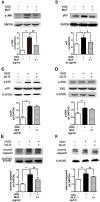MLIF Alleviates SH-SY5Y Neuroblastoma Injury Induced by Oxygen-Glucose Deprivation by Targeting Eukaryotic Translation Elongation Factor 1A2
- PMID: 26918757
- PMCID: PMC4769291
- DOI: 10.1371/journal.pone.0149965
MLIF Alleviates SH-SY5Y Neuroblastoma Injury Induced by Oxygen-Glucose Deprivation by Targeting Eukaryotic Translation Elongation Factor 1A2
Abstract
Monocyte locomotion inhibitory factor (MLIF), a heat-stable pentapeptide, has been shown to exert potent anti-inflammatory effects in ischemic brain injury. In this study, we investigated the neuroprotective action of MLIF against oxygen-glucose deprivation (OGD)-induced injury in human neuroblastoma SH-SY5Y cells. MTT assay was used to assess cell viability, and flow cytometry assay and Hoechst staining were used to evaluate apoptosis. LDH assay was used to exam necrosis. The release of inflammatory cytokines was detected by ELISA. Levels of the apoptosis associated proteins were measured by western blot analysis. To identify the protein target of MLIF, pull-down assay and mass spectrometry were performed. We observed that MLIF enhanced cell survival and inhibited apoptosis and necrosis by inhibiting p-JNK, p53, c-caspase9 and c-caspase3 expression. In the microglia, OGD-induced secretion of inflammatory cytokines was markedly reduced in the presence of MLIF. Furthermore, we found that eukaryotic translation elongation factor 1A2 (eEF1A2) is a downstream target of MLIF. Knockdown eEF1A2 using short interfering RNA (siRNA) almost completely abrogated the anti-apoptotic effect of MLIF in SH-SY5Y cells subjected to OGD, with an associated decrease in cell survival and an increase in expression of p-JNK and p53. These results indicate that MLIF ameliorates OGD-induced SH-SY5Y neuroblastoma injury by inhibiting the p-JNK/p53 apoptotic signaling pathway via eEF1A2. Our findings suggest that eEF1A2 may be a new therapeutic target for ischemic brain injury.
Conflict of interest statement
Figures





Similar articles
-
MLIF Modulates Microglia Polarization in Ischemic Stroke by Targeting eEF1A1.Front Pharmacol. 2021 Sep 7;12:725268. doi: 10.3389/fphar.2021.725268. eCollection 2021. Front Pharmacol. 2021. PMID: 34557098 Free PMC article.
-
Cardioprotective effects of monocyte locomotion inhibitory factor on myocardial ischemic injury by targeting vimentin.Life Sci. 2016 Dec 15;167:85-91. doi: 10.1016/j.lfs.2016.10.021. Epub 2016 Oct 20. Life Sci. 2016. PMID: 27773717
-
A pentapeptide monocyte locomotion inhibitory factor protects brain ischemia injury by targeting the eEF1A1/endothelial nitric oxide synthase pathway.Stroke. 2012 Oct;43(10):2764-73. doi: 10.1161/STROKEAHA.112.657908. Epub 2012 Jul 24. Stroke. 2012. PMID: 22829547
-
The monocyte locomotion inhibitory factor an anti-inflammatory peptide; therapeutics originating from amebic abscess of the liver.Recent Pat Endocr Metab Immune Drug Discov. 2011 Jan;5(1):7-12. doi: 10.2174/187221411794351888. Recent Pat Endocr Metab Immune Drug Discov. 2011. PMID: 22074573 Review.
-
Anti-inflammatory Strategies in Stroke: a Potential Therapeutic Target.Curr Vasc Pharmacol. 2016;14(1):98-105. doi: 10.2174/1570161113666150923111329. Curr Vasc Pharmacol. 2016. PMID: 26411421 Review.
Cited by
-
MLIF Modulates Microglia Polarization in Ischemic Stroke by Targeting eEF1A1.Front Pharmacol. 2021 Sep 7;12:725268. doi: 10.3389/fphar.2021.725268. eCollection 2021. Front Pharmacol. 2021. PMID: 34557098 Free PMC article.
-
Oncogenic activation of EEF1A2 expression: a journey from a putative to an established oncogene.Cell Mol Biol Lett. 2024 Jan 3;29(1):6. doi: 10.1186/s11658-023-00519-9. Cell Mol Biol Lett. 2024. PMID: 38172654 Free PMC article. Review.
-
HIF-1α/Beclin1-Mediated Autophagy Is Involved in Neuroprotection Induced by Hypoxic Preconditioning.J Mol Neurosci. 2018 Oct;66(2):238-250. doi: 10.1007/s12031-018-1162-7. Epub 2018 Sep 10. J Mol Neurosci. 2018. PMID: 30203298 Free PMC article.
-
SAM, a cystathionine beta-synthase activator, promotes hydrogen sulfide to promote neural repair resulting from massive cerebral infarction induced by middle cerebral artery occlusion.Metab Brain Dis. 2022 Jun;37(5):1641-1654. doi: 10.1007/s11011-022-00976-9. Epub 2022 Apr 7. Metab Brain Dis. 2022. PMID: 35386034
-
NR4A2 Exacerbates Cerebral Ischemic Brain Injury via Modulating microRNA-652/Mul1 Pathway.Neuropsychiatr Dis Treat. 2020 Oct 6;16:2285-2296. doi: 10.2147/NDT.S265601. eCollection 2020. Neuropsychiatr Dis Treat. 2020. PMID: 33116527 Free PMC article.
References
-
- Gimenez Scherer JA, Rico G, Fernandez-Diez J, Kretschmer RR. Inhibition of contact cutaneous delayed hypersensitivity reactions to DNBC in guinea pigs by the monocyte locomotion inhibitory factor (MLIF) produced by axenically grown Entamoeba histolytica. Arch Med Res. 1997;28 Spec No: 237–238. - PubMed
-
- Zhang Y, Chen J, Li F, Li D, Xiong Q, Lin Y, et al. A pentapeptide monocyte locomotion inhibitory factor protects brain ischemia injury by targeting the eEF1A1/endothelial nitric oxide synthase pathway. Stroke. 2012;43(10): 2764–2773. - PubMed
Publication types
MeSH terms
Substances
LinkOut - more resources
Full Text Sources
Other Literature Sources
Research Materials
Miscellaneous

